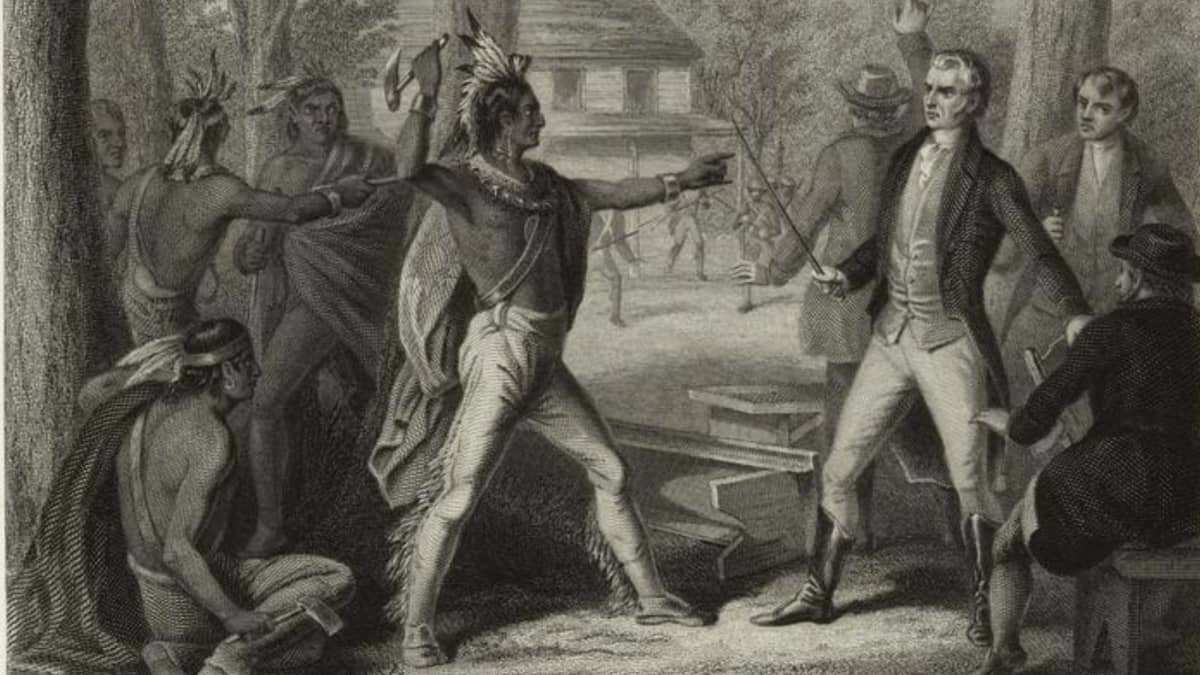
Portrait of Tecumseh, the Shawnee leader who sought to unite Indigenous tribes against U.S. expansion in the early 19th century
In 1811, Tecumseh, a prominent Shawnee leader, delivered a passionate speech called the “Address To The Osage”, to the Osage people living in present-day Missouri. Born into a family deeply affected by ongoing conflicts between indigenous people and American settlers as he lost his father Puckshinwa, in battle against Virginia militiamen in 1774. This early experience would greatly shape later advocacy as at the heart of his message was a call for unity among the Native American tribes to resist American settlement. Tecumseh’s speech to the Osage was delivered during heightened tension between Native American tribes and the rapidly expanding United States following the Louisiana Purchase encapsulating his feelings on the conflicts he witnessed between Native Americans and the expanding United States in the early 19th century.

Tecumseh confronts William Henry Harrison during tense negotiations
As stated previously the early 1800s were marked by aggressive American expansion westward, enabled by actions such as the Louisiana Purchase in 1803, which accelerated settlers pushing into areas inhabited by indigenous groups. Marshall Shelser highlights the consequences of this expansion noting that American Territorial ambitions represented a “direct challenge” to indigenous sovereignty and led to “profound indigenous concerns over sovereignty and cultural survival.”¹ Because of this threat, leaders such as Tecumseh emerged who recognized the danger posed by American expansion advocating for a pan-Indian confederacy as a strategy to halt American encroachment. Tecumseh’s pan-Indian confederacy went beyond tribal affiliations, emphasizing shared identity as well as mutual defense among diverse indigenous communities. Through his speech to the Osage Tecumseh intended to get the Osage to join the pan-Indian confederacy emphasizing the importance of indigenous unity, shared identity, and spiritual renewal.² Through an alliance, he argued that they could defend their territories, preserve their way of life, and reclaim autonomy from the expanding United States.
The “Address to the Osage” is significant not only because of its message of unity and resistance but also because of the rhetorical strategies intended to evoke emotion among the audience. Throughout his speech, Tecumseh uses words aimed to illustrate the shared cultural values, and experiences among the audience creating a sense of urgency and purpose among those listening. One example of this is the repeated use of words such as “Brothers” to show equality among the tribes. In the address, Tecumseh also illustrates the threat that they all face. Tecumseh states “The white men are not friends to the Indians: at first, they only asked for land sufficient for a wigwam; now, nothing will satisfy them but the whole of our hunting grounds.”³ The use of these deliberate linguistic and rhetorical strategies reveals Tecumseh’s deep understanding of relationships among tribes as well as their savvy for creating alliances.
Despite Tecumseh’s eloquence and knack for strategic planning, alliances between tribes such as the Osage and European powers against the Americas were challenging to sustain. Historian Kathleen DuVal suggests that these alliances often struggled due to differing tribal interests and practical struggles in coordinating the broad coalitions.⁴ Duval states “Despite mutual fears of American expansion, lasting cooperation was elusive because each tribe had its distinct political, economic, and diplomatic agendas.” making it difficult to maintain unified alliances. Tribes such as the Choctaw and Creek for example had long-standing animosities, making alliances against a common enemy extremely difficult. Additionally, the southern tribes often lacked a strong backer such as the British who provided outside support to the Northern tribes but could not help in the South. This lack of reliable support weakened the attractiveness of the pan-Indian alliance to these Southern tribes.
Tecumseh’s efforts such as his Address to the Osage can be seen as a prelude to native Americans’ role in the War of 1812. Marshall Smelser states that this conflict was tied to disputes over territory as well as sovereignty, highlighting the stakes of Tecumseh’s movement.¹ Smelser states “Tecumseh’s confederacy was a direct challenge to American territorial ambitions and reflected profound indigenous concerns over sovereignty and cultural survival.” Similarly, Jon Sugden emphasizes that his tour including the speech to the Osage aimed to unify the tribes from the Great Lakes to the Southern Plains represented an unprecedented effort to respond to American expansionism describing Tecumseh’s tour as “one of the most ardent efforts on behalf of eighteenth and nineteenth-century pan-Indianism, and a significant prelude to Indian participation in the War of 1812.”⁵
Today, the “Address to the Osage” is remembered as a testament to the struggle for indigenous autonomy and unity in the face of overwhelming odds. It provides listeners with a lens to understand the persistent impact of colonial expansion on Indigenous people. Tecumseh’s death during the War of 1812 (in 1813) in the Battle of Thames marked not only the end of his life but the end of the pan-Indian movement as well. Despite his passing Tecumseh’s legacy lives on with his powerful words and unwavering commitment to his people’s sovereignty.

Tecumseh addressing a council of American officers and Native leaders, urging unity among tribes to resist U.S. expansion
¹ Marshall Smelser, “Tecumseh, Harrison, and The War of 1812,” Indiana Magazine of History 65, no. 1 (1969): 30.
² John Sugden, “Early Pan-Indianism: Tecumseh’s Tour of the Indian Country, 1811–1812,” American Indian Quarterly 10, no. 4 (1986): 275.
³ Tecumseh, “Address to the Osage,” Teaching American History, https://teachingamericanhistory.org/document/address-to-the-osage/.
⁴ Kathleen DuVal, “Choosing Enemies: The Prospects for an Anti-American Alliance in the Louisiana Territory,” The Arkansas Historical Quarterly 62, no. 3 (2003): 240.
⁵ John Sugden, “Early Pan-Indianism: Tecumseh’s Tour of the Indian Country, 1811–1812,” American Indian Quarterly 10, no. 4 (1986): 290.